

Dr. Anne O’Farrell * , Professor Anthony Staines ** , Professor Patrick Goodman † , Mr. Charles Roarty ^ & Dr. Robert Conway * * Health Intelligence Unit, HSE ** Dublin City University (DCU) † Technological University Dublin. ^ Energy Action Ireland, Dublin .
Definition of fuel poverty: Fuel poverty = when someone is unable to afford to heat their home to a level that is healthy and safe. Households are considered to be in ‘fuel poverty’ if they have to spend >10% of their household income on fuel to keep their home warm.
Determinants of fuel poverty:
Carbon Tax in Ireland: Carbon tax introduced in Ireland in 2010 but solid fuel exempted. Solid Fuel Carbon Tax (SFCT) introduced in 2013 and is an excise duty that applies to coal and peat supplied in Ireland on or after 1 May 2013: € 10 per tonne of CO2 emitted from May 1 st 2013 € 20 per tonne of CO2 emitted effect from May 1st 2014. € 26 per tonne of CO2 emitted effect from May 1 st 2020
Impact of carbon tax: Ireland is committed to increasing the price of carbon from €20 to €80 per tonne by 2030. € 6 increase on 1st May 2020 This increase will have bigger impact on solid fuels such as coal & briquettes. The most vulnerable are likely to use these type of fuels to heat their homes.
Type of heating vs. risk of poverty :
Background: Excess Winter Hospitalisations (EWHs) have been observed in Ireland and in other European countries. 1 Previous studies found EWHs are greatest in older persons with respiratory conditions. • Goodman et al (2011) Understanding fuel poverty in the Elderly Population. Research Brief.
Aim: Determine whether excess winter hospitalisations increased in Ireland over study period 2012-2018. Post-introduction of the Carbon Tax on Solid Fuel in Ireland in 2013 and 2014.
Method: All emergency in-patient hospitalisations with principal diagnosis for Respiratory diseases by month extracted from HIPE via Health Atlas: Aged ≥ 65 yrs 2012-2018
Analysis : Statistical analyses were carried out in: JMP Statsdirect
Excess winter hospitalisations WHO calculation: Winter hospitalisations = hospitalisations occurring in the 4 months of winter (Dec-Mar) Non-Winter hospitalisations = hospitalsations occurring the 4 months preceding (Aug-Nov) the Winter period and the 4 months following on from the Winter (Apr-July) 𝐹𝑦𝑑𝑓𝑡𝑡 𝑋𝑗𝑜𝑢𝑓𝑠 𝐼𝑝𝑡𝑞𝑗𝑢𝑏𝑚𝑗𝑡𝑏𝑢𝑗𝑝𝑜𝑡 = a − ( 𝑐 2 ) where a =number of winter hospitals and b = number of non-winter hospitals
Excess Winter Hospitalisation Index: EWHI = the excess winter hospitalisations expressed as a percentage of the average number of hospitalisations in non-winter months. EWH 𝐹𝑋𝐼𝐽 = (Average of Non−Winter Hospitalisations) ∗ 100 𝟘𝟔 % 𝑫𝑱 = 𝐅𝐗𝐈 𝐣𝐨𝐞𝐟𝐲 ± 𝟐. 𝟘𝟕 𝐲 ( √𝐅𝐗𝐈 𝑱𝒐𝒆𝒇𝒚 • ) #𝑭𝑿𝑰
Excess winter hospitalisations for respiratory disease among elderly : 4,177 4500 4,115 3,866 3,702 4000 3,369 3500 2,846 3000 2500 2000 1500 1000 500 0 2012/13 2013/14 2014/15 2015/16 2016/17 2017/18 Excess winter hospitalisations for respiratory diseases N=22,075 excess emergency hospitalisations for respiratory diseases for those aged ≥65 yrs in 6 year study period.
Excess winter hospitalisations for respiratory disease among elderly: 60% Percentage excess hospitalisations 50% 49.1% 41.8% 42.7% 41.8% 35.8% 40% 33.6% 30% 20% 10% 0% 2012/13 2013/14 2014/15 2015/16 2016/17 2017/18 41.8% excess hospitalisations in 2017/18 vs. 33.6% in 2012/13
Results: Excess winter hospitalisations for respiratory conditions among those aged ≥65 years exists in Ireland today: Increased from 2,846 in 2012/13 to 4,115 in 2017/18 33.6% excess hospitalisations in 2012/13 vs. 41.8% in 2017/18
Discussion: Cold homes are likely one of the causes of excess winter hospitalisations for respiratory illness in the elderly. These are potentially avoidable admissions. Norway vs. Ireland similar size Norway colder winters but: Much less winter morbidity and mortality. Housing stock in Norway much better.
What is being done: Fuel Allowance: 372,259 households in receipt of means-tested fuel allowance in 2019. Recipients currently get €22.50 per week for 28 weeks; will now rise to €24.50 per week. This increase should ameliorate the effect of an increase in carbon tax in the short term. Open-ended increases in fuel allowance without retro-fitting properties to improve energy efficiency is likely to be unsustainable in the longer term.
What is being done : Warmer homes scheme: A free home insulation service to qualifying households. Low-income households Elderly households Vulnerable households* Improve the energy efficiency and comfort conditions of homes. € 52.8 million – more than double the initial allocation for 2019. * Those receiving either winter fuel allowance, job seekers allowance for over 6 months (and with children <7yrs); those receiving family income support and other mean-tested supports.
Table 1. Disbursement of Additional Carbon Tax Receipts in 2020.
What more will be done: As outlined in Table 1 money from the increase in carbon tax will be ring-fenced for: Increased fuel allowance: - Extra €21m Retro-fitting of poor housing stock: Extra €13m allocated in this years budget for energy poverty efficiency upgrades. Warmer homes Reduced Carbon emissions\Improved air quality Extra €20m allocated for aggregated housing upgrade scheme targetted at the Midlands: Upgrade social housing stock in the region. Support 400 jobs.
Conclusions: We welcome these measures as they: Support the households likely to be most impacted by the increase in carbon tax. Short – term by increasing fuel allowance Longer-term by improving energy efficency in retro- fitted homes. Leading in time to: Reduced hospitalisations for respiratory conditions Reduced carbon emissions Reduced carbon emissions leading to improved air quality.
Conclusions: Energy Action Ireland are to be commended for their work in alleviating fuel poverty: By providing high quality free insulation services in the homes of older people and the disadvantaged. By providing work opportunities for long term unemployed in this area .
Acknowledgements: HPO, Health Atlas and CSO for data Co-authors Energy Action Ireland
Recommend
More recommend